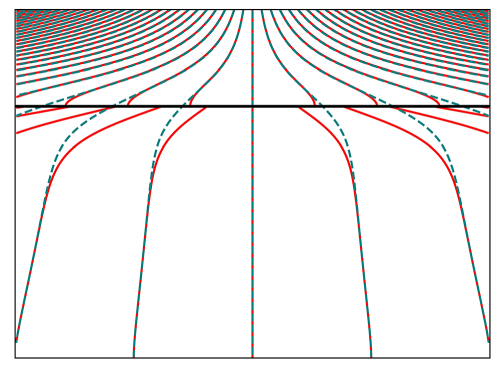No CrossRef data available.
Published online by Cambridge University Press: 04 June 2025

We derive boundary conditions for two-dimensional parallel and non-parallel flows at the interface of a homogeneous and isotropic porous medium and an overlying fluid layer by solving a macroscopic closure problem based on the asymptotic solution to the generalised transport equations (GTE) in the interfacial region. We obtained jump boundary conditions at the effective sharp surface dividing the homogeneous fluid and porous layers for either the Darcy or the Darcy–Brinkman equations. We discuss the choice of the location of the dividing surface and propose choices which reduce the distance with the GTE solutions. We propose an ad hoc expression of the permeability distribution within the interfacial region which enables us to preserve the invariance of the fluid-side-averaged velocity profile with respect to the radius  $r_0$ of the averaging volume. Solutions to the GTE, equipped with the proposed permeability distribution, compare favourably with the averaged solutions to the pore-scale simulations when the interfacial thickness
$r_0$ of the averaging volume. Solutions to the GTE, equipped with the proposed permeability distribution, compare favourably with the averaged solutions to the pore-scale simulations when the interfacial thickness  $\delta$ is adjusted to
$\delta$ is adjusted to  $r_0$. Numerical tests for parallel and non-parallel flows using the obtained jump boundary conditions or the generalised transport equations show quantitative agreement with the GTE solutions, with experiments and pore-scale simulations. The proposed model of mass and momentum transport is predictive, requiring solely information on the bulk porosity and permeability and the location of the solid matrix of the porous medium. Our results suggest that the Brinkman corrections may be avoided if the ratio
$r_0$. Numerical tests for parallel and non-parallel flows using the obtained jump boundary conditions or the generalised transport equations show quantitative agreement with the GTE solutions, with experiments and pore-scale simulations. The proposed model of mass and momentum transport is predictive, requiring solely information on the bulk porosity and permeability and the location of the solid matrix of the porous medium. Our results suggest that the Brinkman corrections may be avoided if the ratio  $a=\delta /\delta _B$ of the thickness
$a=\delta /\delta _B$ of the thickness  $\delta$ of the interfacial region to the Brinkman penetration depth
$\delta$ of the interfacial region to the Brinkman penetration depth  $\delta _B$ is large enough, as the Brinkman sub-layer is entirely contained within the interfacial region in that case. Our formulation has been extended to anisotropic porous media and can be easily dealt with for three-dimensional configurations.
$\delta _B$ is large enough, as the Brinkman sub-layer is entirely contained within the interfacial region in that case. Our formulation has been extended to anisotropic porous media and can be easily dealt with for three-dimensional configurations.